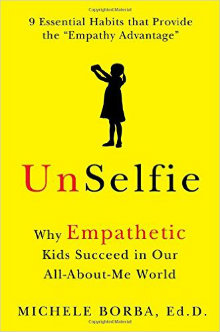How to Teach Empathy at Home and School
UnSelfie: Why Empathetic Kids Succeed in Our All-About-Me World
By Michele Borba, Ed.D.
(Touchstone, 2016 – Learn more)
 Reviewed by Mary Langer Thompson
Reviewed by Mary Langer Thompson
What do kids really need to be happy and successful? Empathy is Michelle Borba’s answer, the reason being that it “…is the one human capacity that allows us to link minds and hearts across cultures and generations to transform our lives.” It’s not an inborn trait, however, and must be taught.
 But exactly what is empathy? Borba defines it as feeling “with” others, “always a ‘We’ experience.” It’s learning to walk in another’s shoes. And why should we want this for our kids?
But exactly what is empathy? Borba defines it as feeling “with” others, “always a ‘We’ experience.” It’s learning to walk in another’s shoes. And why should we want this for our kids?
The author lists several advantages, including future health and wealth; relationship satisfaction; moral courage; an antidote to bullying, aggression, and racism; a predictor of reading and math skills; a path to critical thinking skills, and an essential ingredient for leadership success. Empathy is everything that makes a society civilized.
Beyond selfies to teachable moments
Unfortunately, today’s culture is more “Me” than “We.” “Selfie” was the word of the year in 2014. We, as parents and educators, should be concerned because research shows a dip in empathy among youth and an increase in peer cruelty, cheating and bullying. Kids have weaker moral reasoning skills, Borba reports. As anxiety increases, empathy wanes, and we live in a plugged-in, high-pressure culture.
Borba was influenced to write about empathy because of her research on school violence, the raising of her own children, and visits to areas where genocide occurred, such as the Cambodian Killing Fields, Auschwitz, Armenia, and Rwanda.
Borba maintains that empathy is composed of teachable habits that can be practiced and developed. She discusses the nine essential habits of empathetic children. They include emotional literacy, moral identity, perspective taking, and moral imagination. She talks about practicing empathy by regulating the self, practicing kindness, and collaborating.
What does it take to live empathetically?
Children need to acquire moral courage, the ability to speak out, step in, and help others. Altruistic leadership abilities make a difference for others. She recommends choosing one skill a month and practicing it a few minutes each day. “The foundation for empathy is face to face human connection.”
This is why adults need to create “sacred” unplugged times. Focusing on others expands our world. According to kids, cell phones are the top parent distractor when children try to talk to us.
The reader will find many practical suggestions for raising empathetic children. One is to become an “emotion coach” by using a baby. Other suggestions are to raise a puppy, tutor another child, and to Skype Grandma. Teach how to name feelings: “It looks like you’re angry.” “You sound irritated.” Saying how you feel is like medicine. Families, classrooms, and individuals can develop an ethical code (Sully, John Wooden) and a personal and family mantra (“Our family steps in to help”) or the right words to live by. Praise moral accomplishments such as compassion and generosity.
But be careful with over-exuberant praise in other areas that leads to narcissism. (See the MiddleWeb review of Jessica Lahey’s The Gift of Failure.) Moral education begins in childhood. Although Borba mentions Lawrence Kohlberg’s Stages of Moral Development, she dismisses his theory, saying he leaves out empathy: “You can reason morally but lack empathy.” Kohlberg, however, based the teaching of morality on dilemmas, and depending on the dilemma and the guided questioning of the teacher, I believe Kohlberg’s philosophy can be another tool to teach empathy.
From home to classroom to school
The author clearly wants to give kids “the empathy advantage.” Learn why she thinks we can’t give up on kids by expelling them, spanking them, yelling, time-out and isolation. She gives six practical ways to help kids walk in another’s shoes, including props, puppets, action figures, using real events in the news, films, and books.
There is an entire chapter on “Reading to Cultivate Empathy,” with specific books named. Reading can make us kinder, but kids are reading less. Learn why picture books are crucial to empathy development and why literary fiction produces empathy (literary fiction actually lights up your brain!). She suggests books that will make even “tough kids” melt.
There are practices that can be done school-wide, too, such as “Restorative Justice Circles,” robotics, language classes, tutoring. A quiet time twice daily in a San Francisco middle school in a violent neighborhood showed a forty-five percent reduction in violence in the first year.
Parents and teachers will love the sections on modeling calmness and ways to tune into their child, such as blowing bubbles, breathing, and listening to music. Age-by-age strategies are given, too. Research shows that most kids believe their parents value achievement over caring. This book will help you change their minds.
Although many programs, ideas, books and websites are cited, missing are some like Love and Logic, in place since the 70’s with a focus on delivering empathy in every tense encounter; or Project Wisdom, and even Sunday School. She is familiar, however, with the Ashoka Changemaker Schools that prioritize empathy.
Acting to encourage empathy
We need to get back to teaching ethics and empathy. UnSelfie is a great place to start for parents, grandparents, and educators. This book doesn’t complain about the lack of civility and caring we all see, but tells the reader what to do about it. Borba quotes Thoreau to ask us an important question:
Could a greater miracle take place than for us to look through each other’s eyes for an instant?”
Let Borba help you give kids the edge – and the empathy – to succeed.
 Dr. Mary Langer Thompson’s articles, short stories, and poetry appear in various journals and anthologies. She is a retired school principal who now writes and teaches writing workshops in schools, prisons, and in her community. Her anti-bullying children’s book, How the Blue-Tongued Skink Got His Blue Tongue has just been released.
Dr. Mary Langer Thompson’s articles, short stories, and poetry appear in various journals and anthologies. She is a retired school principal who now writes and teaches writing workshops in schools, prisons, and in her community. Her anti-bullying children’s book, How the Blue-Tongued Skink Got His Blue Tongue has just been released.

































